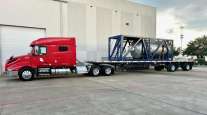Flatbed Carriers Await Spring’s Freight Bloom

This story appears in the April 6 print edition of Transport Topics.
Flatbed freight markets in the early spring generally are solid, but the hoped-for surge from housing-related business hasn’t yet begun.
That broad message emerged from carrier officials around the country who spoke with Transport Topics as the second quarter got under way.
“We are hearing from several building products companies that they are expecting a good year, though it has started more slowly than they anticipated,” said Rick Williams, CEO of Central Oregon Truck Co. “In general, it is too early to tell how the year will play out” in the housing sector.
“Right now, we are all trying to blame it on the weather because that is such a huge factor in the construction business,” said Williams, whose Redmond, Oregon, company is a unit of Daseke Inc. of Addison, Texas — No. 59 on Transport Topics Top 100 list of for-hire carriers in the United States and Canada. “It’s hard to say how much of the start that is slower than anticipated is related to the weather and how much is economic conditions.”
Gary Salisbury, CEO of Fikes Truck Line, said he believes a round of late-winter weather problems in many parts of the country have pushed back the expected surge in flatbed freight to home improvement stores.
“Building products are going to move to those stores in the next 30 days,” Salisbury said in an interview March 27. Demand will surge, he said, as retailers replenish inventory such as roofing materials.
In the meantime, Salisbury and Williams sketched a market where supply and demand generally were in balance.
Salisbury said “business has been steady” at his Hope, Arkansas-based company. “Shippers are not calling for trucks, and we not looking for freight.”
Williams said, “Overall, we are doing well.”
Mark Montague, an analyst at load board operator DAT, told TT the single-family housing market was “disappointing” through early March, adding that “a lot of people thought it would be a star.”
One sign of weakness was a 17% decline in housing starts in February from January and 3.3% below a year ago, because of bad weather, according to a joint announcement from the U.S. Department of Housing and Urban Development and Census Bureau. While home construction was moving slowly, new-home sales rose 7.8% in February from January and 24.8% from a year ago, the agencies said.
Bob Costello, American Trucking Associations’ chief economist, maintains that the housing market will strengthen this year. He predicts an 18% gain in housing starts during 2015.
Flatbed fleets that specialize in hauling other types of freight for the construction and industrial markets were upbeat in general, though they did note weak spots.
Joe Giammona, president of Acampo, California-based JSG Trucking Co., described mixed flatbed markets in the nation’s most populated state.
“The manufacturing portion [of the flatbed market] seems pretty normal,” he told TT on March 31. “It came back up in February.” However, construction in California, where weather wasn’t a factor in the first quarter, hasn’t picked up again after a dropoff that began in November.
“We are optimistic about our base business,” such as hauling manufactured products, he said, while being “hopeful” that the state’s construction market will rebound.
“Last year, the flatbed market rebounded. It was better than it has been since 2008,” said John Summers, vice president at K&B Summers Inc. “It’s supposed to be even better this year.”
Summers said his Ephrata, Pennsylvania-based company, whose freight includes precast concrete and windows for commercial buildings, has benefited from continued strong demand in that sector.
Bob Peterson, president of Melton Truck Lines Inc., described business as “very solid, but not blistering.”
His Tulsa, Oklahoma-based flatbed fleet, which hauls commercial air conditioning systems is benefiting from an industrial economy that is “pretty darn decent” in every sector other than energy, he said.
“Flatbed in general is what I would call squishy,” said Jim Towery, president of Steelman Transportation, after a strong five-year run.
“We are busy, and our rates are holding,” he said just before the end of the first quarter when freight typically surges. “But there is no pressure building.”
For his Springfield, Missouri-based company, he added: “The end-of-quarter push just isn’t happening.”
Said Joyce Brenny, CEO of Brenny Transportation Inc.: “Business is not stellar by any means. We are staying busy, but it’s not off the charts. I’m not concerned by any means.”
She cited two factors that have hurt freight levels for the St Joseph, Minnesota-based carrier’s flatbed division that hauls freight including machinery and steel.
One is the strong U.S. dollar, which has dented demand in Brenny’s cross-border freight. Another is the decline in freight demand as exploration dipped in the North Dakota oil fields after the decline in the price of crude.
The lower exploration activity has redirected carriers that used to haul that freight scurrying to load boards to find any kind of flatbed freight, Towery added. One sign of that activity was a recent pickup in the flatbed business on DAT’s load board.


